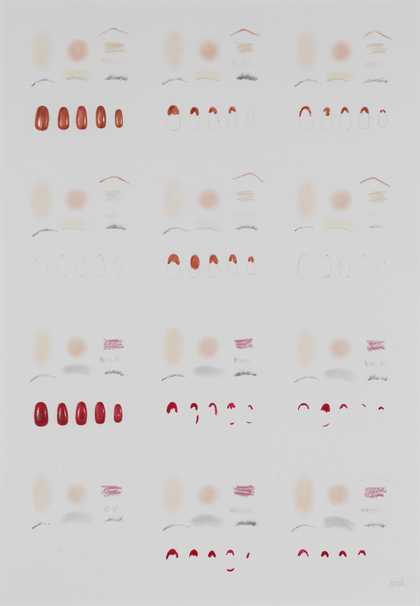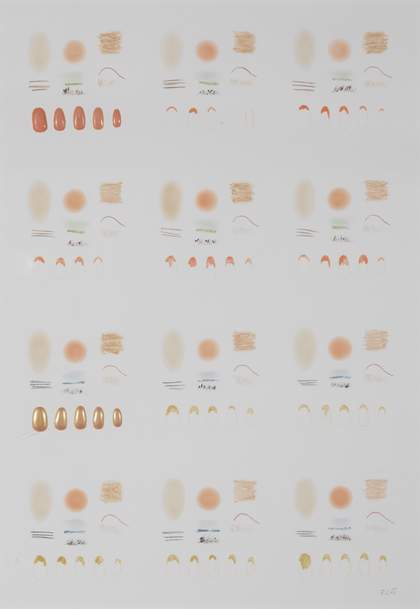
Běla Kolářová working on an assemblage with paper clips, photographed by André Villers, 1969
© ADAGP, Paris and DACS, London 2016, courtesy Estate of Běla Kolářová
Běla Kolářová was an unassuming but quietly influential figure in former Czechoslovakia’s Cold War-era avant-garde. While a lack of formal training excluded her from the communist regime’s official art circuit, her work was celebrated in many of the key counter-cultural exhibitions of her day.
Kolářová took up photography in earnest in her thirties, when a bout of tuberculosis forced her to leave the Prague publishing house where she had worked for 15 years. With her Flexaret camera, she captured scenes of children playing on the capital’s streets – karting up roads, skipping, sliding down concrete handrails – for her first series, Children’s Games 1957.
While these candid snapshots of urban life invited associations with street photography and reportage, she would later distance herself from these labels, citing a more modest, original ambition for her own art. In the only known comprehensive statement about her work, she recalled her distaste at reading a bombastic declaration by ‘Cartier-Bresson or some other photographer’, which asserted: ‘The entire world has been photographed!’ In response, she resolved to use the medium to focus on more intimate subject matter overlooked by others, ‘a world so negligible and everyday as if past the merit of being photographed’.
Kolářová began to experiment with camera-less photography, customising techniques pioneered by Man Ray and interwar exponents of the New Vision movement such as László Moholy-Nagy. In 1961 she made her first ‘artificial negatives’ by placing small objects between two cellophane sheets or lodging them in a layer of soft paraffin wax spread on the surface of a celluloid sheet. Projecting these directly on to light-sensitive bromide paper, the subsequent images (which she labelled ‘vegetages’, ‘photo-collages’ or ‘traces’) sought to capture the unique qualities and textures of anything from bean pods to loose cotton threads: ‘All those bits and scraps from dining tables and desks… a ticket after a completed journey or a piece of wrapping paper from a sweet we’ve just eaten.’
Her Roentgenogram of a Circle photograms from 1963 saw Kolářová attach sheets of photographic paper to a rotating device before focusing beams of light on to them through a sieve, resulting in the registration of spectral circles reminiscent of X-rays. Following further experiments with ‘arranged photographs’ – in which she applied the glossy sheen of advertising photography to tightly composed arrangements of domestic detritus, such as cracked eggshells and Staropramen beer caps dented by bottle openers – in 1964 she put down her camera to explore the tactile, ever-shifting qualities of these objects in three dimensions.
In 1966, the year of her first solo exhibition in Prague, she made a series of assemblages called Dishes, consisting of items such as hairpins, snap fasteners and costume jewellery glued on to square pieces of clear or mirrored glass. These serial works and their kaleidoscopic effects recall minimal and op art, though the intimate nature of the materials introduces a different sensibility, fusing the traditional patterns of craft with the aesthetic of the cybernetic age – like circuit boards propped up in Bakelite drying racks. Kolářová’s subsequent works, created during ‘normalisation’ – a period of intense communist regulation that followed the suppression of the short-lived Prague Spring in 1968 – celebrate the fragmentary, readily discarded traces of individual human activity, making protagonists out of paper clips, buttons and razor blades in meticulous, imaginative arrangements.

Běla Kolářová, Seekers of Lice I 1976, from the series Make-up Drawings, acrylic nails, nail varnish and cosmetics on paper, 55.7 x 38.5 cm
© Estate of Běla Kolářová, courtesy Tate Photography

Běla Kolářová, Seekers of Lice II 1976, from the series Make-up Drawings, acrylic nails, nail varnish and cosmetics on paper, 55.7 x 38.5 cm
© Estate of Běla Kolářová, courtesy Tate Photography
In her later Make-up Drawings she would again explore the often unnoticed materials and trappings of female experiences. In the Seekers of Lice pictures from 1976, cheek-sized halos of blusher, sets of false nails and creams, dyes and stains are arranged in regular 4x3 grids, each swatch the shadow of a woman’s daily routine. Eyeliner traces the contours of absent eyelids, while mascara is applied directly from brush to page, reminding us, in Kolářová’s words, that ‘all these things are a part of us, they speak about our daily life, they bear witness to us and therefore are worthy of our notice’.
